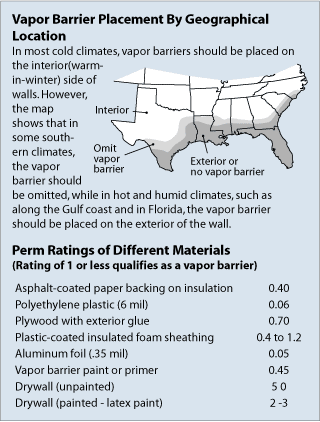vapor retarder

A vapor retarder is a material that retards the movement of water vapor through a building element (walls, ceilings) and prevents insulation and structural wood from becoming damp and metals from corroding. The term is often applied to insulation batts or separately in the form of treated papers, plastic sheets, and metallic foils.
The older term "vapor barrier" is still used even though it may inaccurately imply that the material stops all of the moisture transfer. Since everything allows some water vapor to diffuse through it to some degree, the term "vapor retarder" or "vapor diffusion retarder" is more accurate.
The ability of a material to retard the diffusion of water vapor is measured by units known as "perms" or permeability. A perm at 73.4°F (23°C) is a measure of the number of grains of water vapor passing through a square foot of material per hour at a differential vapor pressure equal to one inch of mercury (1" W.C.) Any material with a perm rating of less than 1.0 is considered a vapor retarder.
Vapor retarders can help control moisture in these areas:
Effective moisture control in these areas and throughout a home includes air sealing gaps in the structure, not just the use of a vapor retarder.
How, where, and whether a vapor diffusion retarder should be used depends on the climate. Typically, the number of heating degree days in an area is used to help make these determinations. A heating degree day is a unit that measures how often outdoor daily dry-bulb temperatures fall below an assumed base, normally 65°F (18°C).
Types of vapor retarders
Vapor retarders are typically available as membranes or coatings. Membranes are generally thin, flexible materials, but also include thicker sheet materials sometimes called "structural" vapor diffusion retarders. Materials such as rigid foam insulation, reinforced plastics, aluminum, and stainless steel are relatively resistant to water vapor diffusion. These types of vapor diffusion retarders are usually mechanically fastened and sealed at the joints.
Thinner membrane types come in rolls or as integral parts of building materials. A common example of this is aluminum- or paper-faced fiberglass roll insulation. Foil-backed wallboard is another type commonly used. Polyethylene, a plastic sheet material, can be used as a vapor diffusion retarder for above-grade walls and ceilings (only) in very cold climates (in locations with 8,000 heating degree days or higher).
Most paint-like coatings also retard vapor diffusion. While it was once believed that only coatings with low perm ratings constituted the only effective vapor diffusion retarders, it is now believed that any paint or coating is effective at restricting most water vapor diffusion in milder climates.
Installing vapor retarders for new construction
In climates with less than 4,000 heating degree days, materials like painted gypsum wallboard and plaster wall coatings impede moisture diffusion to acceptable levels. Usually, no further vapor diffusion retarder is needed.
In more extreme climates, vapor diffusion retarders are advisable for new construction. They perform best when installed closest to the warm side of a structural assembly; in cold climates, this is towards the interior of the building. In hot/wet climates, this is towards the exterior of the building.
Reasonable rules-of-thumb to follow when placing vapor retarders include the following:
Knowledgeable builders typically use vapor diffusion retarders with ratings of 0.1 or less. However, if you carefully seal the warm-side vapor diffusion retarder and interior finish, you can also safely install a low-permeable material, such as rigid foam board insulation (a perm rating as high as 1.4), on the cold side of walls. A good rule-of-thumb: to prevent trapping any moisture in a cavity, the cold-side material's perm rating should be at least five times greater than the value of the warm-side. Use a vapor diffusion retarder with a perm value of less than 0.50 if you also have a high water table.
When installing a vapor diffusion retarder, it should be continuous and as close to perfect as possible. This is especially important in very cold climates and in hot and humid climates. Be sure to completely seal any tears, openings, or punctures that may occur during construction. Cover all appropriate surfaces; otherwise, you risk moist air condensing within the cavity, which would lead to dampened insulation. The thermal resistance of wet insulation is dramatically decreased, and prolonged wet conditions will induce mold and wood rot.
Installing vapor retarders in existing homes
Except for extensive remodeling projects, it's difficult to add materials like sheet plastic as a vapor diffusion retarder to an existing home. However, many existing homes don't really need a more effective vapor diffusion retarder than the numerous layers of paint usually on their walls and ceilings. These multiple layers are quite effective as a vapor diffusion retarder in all but the most extreme northern climates.
There are some solutions that can be applied internally to an existing home's foundation, such as plastics or other inorganic vapor barrier membranes that can act as vapor retarders.
"Vapor barrier" paints are also an effective option for colder climates. If the perm rating of the paint is not indicated on the label, find the paint formula. The paint formula usually indicates the percent of pigment. To be a good vapor diffusion retarder, it should consist of a relatively high percent of solids and thickness in application. Glossy paints are generally more effective vapor diffusion retarders than flat paints, and acrylic paints are generally better than latex paints. When in doubt, apply more coats of paint. It's best to use paint labeled as a vapor diffusion retarder and follow the directions for applying it.
